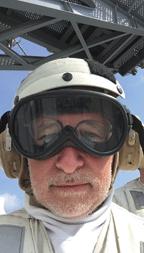
“Firing sequence complete! Salute given! Fire!”
With that, I pushed the red “FIRE” button and launched a $45,000,000 F-18 Hornet Fighter jet from the deck of the U.S.S. Harry S. Truman in the middle of the Atlantic.
How do I describe that experience? AWESOME.
In the beginning of August, I — along with 11 others — were guests of the United States Navy. {mprestriction ids="1,3"}Having been nominated by the U.S.S. Harry S. Truman Foundation — a nonprofit organization meant to create a connection between the Kansas City area and the aircraft carrier Truman and to support its crew — we arrived at Norfolk Naval Station and were helicoptered over to the nuclear-powered Truman in the middle of the Atlantic. For two days and one night, we were given what the Navy calls “Distinguished Visitor” status. We saw every aspect of the ship’s operations. The “Truman” was conducting “QO” (qualifying ops), training new fighter pilots how to land and take off from an aircraft carrier. In order to be certified for combat operations, each pilot had to land and be launched successfully six times during the day and six times during the night. With more than 30 pilots needing to qualify, the Truman was a busy place … with more than 100 aircraft going onto and leaving the ship over a 12-hour period. The Truman will be deployed in the Mediterranean in November, stationed in the epicenter of the most tense military spots on the planet. After months in dock and repairs, the crew began preparing for this tour. We watched thousands of pounds of ordnance transferred to the ship. We listened as they conducted a “man overboard” drill, to account for all 3,500 crew onboard. (It took 14 minutes for all crew to be located and accounted.)
Needless to say, it was an incredible once-in-a-lifetime opportunity. I had the privilege of reading from the Torah scroll, kept onboard the Truman, a gift of the Tidewater Jewish Community … one of only two such scrolls on a Navy vessel. We met and dined with the captain, the executive officer, and the command master chief … all of whom were gracious in their attention to our needs and questions. In Norfolk, we met and dined with Rear Admiral Michael Groothousen and Vice Admiral Herman A. Shelanski (the third and fifth captains of the Truman).
During my time onboard, I learned three valuable lessons … lessons that apply in each of our lives … lessons I will carry with me, with thanks to the crew of the U.S.S. Harry S. Truman, the Foundation, and the United States Navy for permitting me to learn.
Lesson No. 1: Even the biggest — and most important — of us can learn to adjust quickly. The Truman — over 1,100 feet long, as tall as a 24-story building, holds 90 aircraft, whose flight deck is 4.5 acres big, and displaces 94,000 tons in the water — can make a 180-degree turn in 8 minutes. And it can come to a complete stop from traveling 35 knots in 3 minutes. How many of us are so flexible in dealing with family, friends and situations? In each of our lives, such agility and maneuverability would be helpful!
Lesson No. 2: To quote a verse from a Paul Simon song … “one man’s ceiling is another man’s floor.” When fully deployed, the Truman houses almost 6,000 personnel. Despite the size of the ship, it is tight quarters. For so many to work effectively together, there is both consideration and cooperation. Only one person can walk through portals at a time. Everyone makes way for the other — literally — in order for movement through the passages to happen. For many of us, we ignore the needs of others — or, at least, push our needs in front of others — because of the press of our own lives. How would our world look if we made each moment one where the one in front of us — and his/her job — is just as important as us?
Lesson No. 3: Believing in your mission changes how one approaches one’s work. I met Lee, an enlisted sailor with 12 years in the Navy. Lee’s job is to chain the planes down to the flight deck and place the wheel chocks down to secure the aircraft. It is a hot and not-free-of-danger job. He loves it and takes great pride in it. When asked why, his answer was simple: “Each time I secure a plane, I am doing my part to secure this world from evil. I believe that we are trying to do good in our work. My job is part of that effort.” Such clarity of mission would benefit each of us in our work, in our families, even dealing with our own selves. The stronger we feel about what we do … the better we will do it!
I will remember for a very long time the thrill of standing on the flight deck, watching as aircraft were catapulted off the deck going from 0 to 170 miles per hour in less than 2 seconds. And watching equally fast traveling fighter jets be “hooked” by a cable, bringing the plane to a full stop within 2 seconds. However, more than anything, I will remember the men and women who serve on the Truman. I will hold close the lessons they taught me … and try to live them here on solid ground … even as they live them on the open seas.
Rabbi Arthur Nemitoff is senior rabbi of The Temple, Congregation B’nai Jehudah.{/mprestriction}